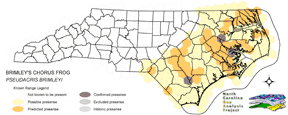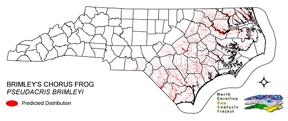
| Taxa: |
| Order: |
| Family: |
| Amphibia |
| Anura |
| Hylidae |
| NatureServe Global Rank: |
| NatureServe State (NC) Rank: |
| G5 |
| S5 |
| Federal Status: |
| NC State Status: |
| --- |
| --- |


| Land Unit |
| US Fish & Wildlife Service |
| US Forest Service |
| US National Park Service |
| US Department of Defense |
| NC State Parks |
| NC University System |
| NC Wildlife Res. Com. |
| NC Forest Service |
| NC Div. of Coastal Mgmt. |
| Local Governments |
| Non-Governmental Org. |
| Other Public Lands |
| Private Lands |
| GAP Status 1-2 |
| All Protected Lands |
| Statewide |
| Hectares |
| 16,029.00 |
| 2,333.70 |
| 7,355.61 |
| 3.51 |
| 4,481.73 |
| 2,201.58 |
| 13,242.15 |
| 1,675.26 |
| 1,063.98 |
| 49.14 |
| 11,160.99 |
| 284.85 |
| 536,429.97 |
| 37,700.64 |
| 59,587.65 |
| 596,311.47 |
| Acres |
| 39,608.51 |
| 5,766.70 |
| 18,176.10 |
| 8.67 |
| 11,074.59 |
| 5,440.22 |
| 32,722.06 |
| 4,139.66 |
| 2,629.15 |
| 121.43 |
| 27,579.40 |
| 703.88 |
| 1,325,547.07 |
| 93,160.29 |
| 147,244.26 |
| 1,473,517.45 |
| % of Dist. on |
| Prot. Lands |
| 26.9 % |
| 3.9 % |
| 12.3 % |
| < 0.1 % |
| 7.5 % |
| 3.7 % |
| 22.0 % |
| 2.8 % |
| 1.8 % |
| 18.7 % |
| 18.7 % |
| < 0.1 % |
| 0.2 % |
| 63.3 % |
| ----- |
| ----- |
| % of Dist. on |
| All Lands |
| 2.7 % |
| 0.4 % |
| 1.2 % |
| < 0.1 % |
| 0.8 % |
| 0.4 % |
| 2.2 % |
| 0.3 % |
| 0.2 % |
| < 0.1 % |
| 1.9 % |
| < 0.1 % |
| 90.0 % |
| 6.3 % |
| ----- |
| ----- |
|
This species is an inhabitant of bottomland hardwood forests near aquatic sites (Wilson 1995). Breeding season habitats include shallow lentic swamps, moist grassy areas, roadside ditches with emergent grasses and reeds, vernal pools (often road ruts) in logged areas, flooded cane stands, flooded pine/hardwood forests, wet edges of pine woodlands, and
ruts and flooded areas in powerline and pipeline crossings. NATURE SERVE GLOBAL HABITAT COMMENTS: Low areas in hardwood forests, swamps near rivers and streams, marshes, and wet open woods. Eggs and larvae develop in flooded ditches and shallow ponds. |
| Code | Name | Description | NC Natural Heritage Program Equivalent |
| 75 | Tidal Swamp Forest | Swamp tupelo dominated forest with or without black tupelo and/or cypress trees. Restricted to the tidal zones in the coastal plain. May have inclusions of coastal red cedar woodlands. | Tidal cypress - gum swamp |
| 50 | Coastal Plain Mixed Bottomland Forests | Includes forests dominated by a variety of hardwood species, including sweetgum, cottonwood, red maple. | Coastal Plain Bottomland Hardwood (in part), Coastal Plain Levee Forest |
| 49 | Coastal Plain Oak Bottomland Forest | Bottomland forests dominated by deciduous oak alliances. Oaks represented can include swamp chestnut, cherrybark, willow, and/or overcup oak. Inclusions of loblolly pine temporarily flooded forests occur in patches. Hydrology is temporarily to seasonally flooded. | Coastal Plain Bottomland Hardwoods (in part) blackwater subtype, brownwater subtype |
| 30 | Cypress-Gum Floodplain Forests | Swamps dominated by black or swamp tupelo with or without Taxodium. Seasonally to semi-permanently flooded hydrology. | Cypress-Gum Swamps |
| 78 | Pond-Cypress - Gum Swamps, Savannas and Lakeshores | Cypress dominated swamps and lakeshores. Can include bays dominated by pond cypress or shorelines of coastal plain lakes with a narrow band of cypress. | Non-riverine Swamp Forest, Natural Lakeshores (in part) |
| 385 | Oak Bottomland Forest and Swamp Forest | The swamp chestnut oak, cherrybark oak, shumard oak and sweetgum alliance is one representative. Other alliances are dominated by water, willow, and overcup oaks. Swamp forests can be dominated by sweetgum, red maple, and black gum being dominant. Loblolly can occur in combination with sweetgum and red maple, or with tulip poplar. Includes saturated and semi- to permanently flooded forests in the mountains. | Piedmont/Mountain Bottomland Forest, Piedmont/Mountain Swamp Forest |
| 384 | Piedmont/Mountain Mixed Bottomland Hardwood Forests | Includes temporarily to seasonally forests dominated by hardwood species. Hardwoods include sweetgum, red maple, sycamore which co-occur in a mosaic of bottomland and levee positions. Includes alluvial hardwood forests in the mountains. Hemlock and white pine may occur as inclusions, but are generally mapped separately. | Piedmont/Mountain Alluvial Forest, Piedmont/Mountain Levee Forest |
|
Wright, A. H. and A. A. Wright. 1949. Handbook of frogs and toads of the United States and Canada. Comstock Publishing Company, Ithica, NY. 640 pp.
Wilson, L. A. 1995. The Land Manager's Guide to the amphibians and reptiles of the South. Chapel Hill, NC: The Nature Conservancy. Cocroft, R. B. 1994. A cladistic analysis of chorus frog phylogeny (Hylidae:PSEUDACRIS). Herpetologica 50:420-437. Hoffman, R. L. 1983. Pseudacris brimleyi. Cat. Am. Amph. Rep. 311.1-311.2. Conant, R. 1975. A Field Guide to Reptiles and Amphibians of Eastern and Central North America. Second Edition. Houghton Mifflin Company, Boston, Massachusetts. xvii + 429 pp. Behler, J. L., and F. W. King. 1979. The Audubon Society field guide to North American reptiles and amphibians. Alfred A. Knopf, New York. 719 pp. Martof, B. S., W. M. Palmer, J. R. Bailey, and J. R. Harrison, III. 1980. Amphibians and reptiles of the Carolinas and Virginia. University of North Carolina Press, Chapel Hill, North Carolina. 264 pp. |
For more information please contact them at:
NC-GAP Analysis Project
Dept. of Zoology, NCSU
Campus Box 7617
Raleigh, NC 27695-7617
(919) 513-2853
www.basic.ncsu.edu/ncgap